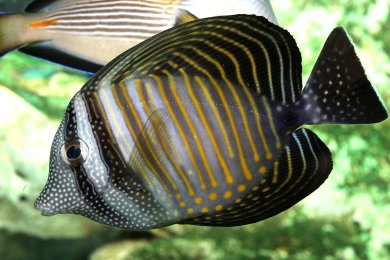
This species comes from the Red Sea and Indian Ocean; along with its close relative Zebrasoma veliferum from the Pacific, it is the largest Zebrasoma tang, potentially growing to 40 cm/16″. If you want to keep one you need a large aquarium. When I decided to set up a large tank, this species was high on my list of intended fish. It is slightly less frequently seen, at least in my local dealers, than most of the popular tangs so I had to wait a while to get one.
The one I eventually bought was about 10 cm long and had been returned to World of Fishes in East Grinstead by a previous owner because she found that it wouldn’t feed.
It was feeding in the shop, however, and shortly after arriving in my quarantine tank it was feeding from my daughter’s hand. It was the second fish to go into the new aquarium (after my Kole tang, Ctenochaetus strigosus), and ever since has been a big favourite with everyone.
In the year it has been in the tank, it has grown to about 15 cm long (and high – when it spreads out its huge fins). It has also become more colourful, developing more of the yellow-orange vertical stripes on the flanks and spots on the belly that characterise this species, together with a purple flush around the “scalpels” on the caudal peduncle.
One surprise was the degree to which this fish can vary its colour. The base colour can be anywhere between chestnut brown and pale grey, occasionally suffused with a strange pale blue sheen, and the intensity of the dark bands through the eye and behind the head and of all the yellow-orange markings can vary tremendously.
The colours can change in seconds. What is particularly interesting is that the reasons for the colour changes aren’t obvious. Other tangs can also vary their colouration, but this usually seems to reflect either aggression (intensification of colour) or stress (pallor), or day to night variation. There seems to be no pattern at all to the sailfin’s colour changes.
It is very bold – whenever I work in the tank it is usually hovering very close to my hands, sometimes even brushing against them (thankfully keeping its scalpels sheathed).
It will feed from anyone’s hand, and whenever I’ve had to use traps to catch other fish it tends to take up residence in them – annoyingly, because it tends to prevent the others going into the trap.
It’s a very calm fish (unlike the other tangs, all of which are a bit jittery) and hardly ever starts fights, although it frequently has to defend itself from my smaller but much more aggressive powder blue.
Another odd feature for a tang is that it seems to have no susceptibility to white spot. I’ve had a couple of outbreaks that started with the powder blue and spread to the other tangs, but the sailfin has never yet been affected.
This species has a reputation as one of the best reef tank algae grazers around, and mine certainly lives up to this.
In the early days of the tank, there was a lot of bubble algae around (there still is in the refugium), and the sailfin cleared all of it, as well as disposing of a lot of hair algae of various types.
So, in summary, this is one of my (and the rest of the family’s) favourites among the fish, and I’m looking forward to observing its continued growth and development, as it becomes ever larger and more stately.



